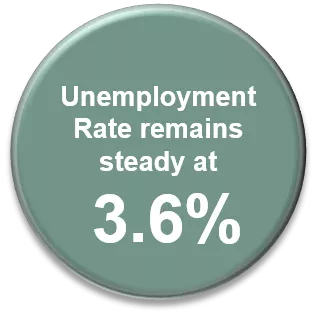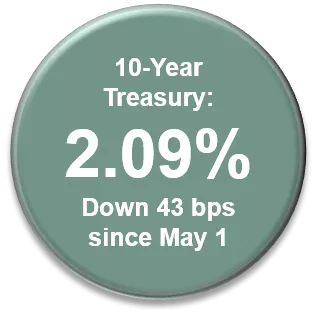Economic Commentary on May 2019 Employment Report

Chief Economist
Pohlad Companies
The impact of the escalating trade war between the U.S. and China was reflected in many of the economic reports published during the past five weeks. Reports on Industrial Production, Imports and Exports, revised GDP, and Employment all demonstrate the fact that the global and domestic economies are slowing. Consequently, the U.S. bond market has seen yields on the 10-year Treasury bond fall by 43 basis points since the beginning of May.
Starting with U.S. Industrial Production, the April report released in mid-May showed that the year-over-year growth rate of Industrial Production has been steadily declining since peaking at 5.4% in September 2018. The April reading is 0.9% year-over-year. The factory sector is much weaker than the overall year-over-year nominal GDP reading of 5.0% would imply.
Reports on both imports and exports indicate slowing in both measures. The growth rate of imports peaked in September as orders were expedited to avoid expected tariffs. The overhang of this inventory buildup is still present, suggesting that economic activity has not been vibrant enough to correct this situation. The export growth rate peaked in May 2018, again reflecting slower consumption demand in foreign economies.
Real 1Q-19 GDP was revised down slightly to 3.1% from 3.2%, but when you strip out the impact of bloated inventories, growth was only 2.5%. Ongoing economic growth is dependent on continued strong participation from consumers. The ongoing strength of the labor market, then, is critical.

Investors, realizing the importance of a strong labor market, were disappointed by the June 7 release of the May Employment report. Although the unemployment rate remained steady at 3.6%, nonfarm payrolls increased by only 75,000, well below expectations of 175,000. For comparison purposes, the first five months of 2018 saw payrolls expand by 1,149,000, while they have only expanded 820,000 in the first five months of 2019. Additionally, year-over-year average hourly earnings grew by 3.1%, down from 3.2% in April. Wage pressures, then, remain very subdued for a labor market that is tight.
In addition to the slower economic activity implied from the numbers above, the most recent reading on core personal consumption inflation (the Fed’s preferred measure) came in at 1.6% as of April.

The bond market, then, seeing slower economic growth and lower inflation numbers, has moved the 10-year Treasury bond yield to 2.09%, down from 2.52% on May 1. This has resulted in parts of the yield curve inverting, with longer-term treasuries yielding less than shorter-term treasuries. As discussed in prior missives, an inverted yield curve has preceded every recession over the past 50 years. The lead time, however, is inexact – ranging from 6 months to 22 months.
Expectations for an interest rate cut by the Fed have also increased dramatically. The Fed Funds futures market now has priced a 78% chance of a Fed rate cut at the July meeting and a 96% chance of a cut at the September meeting if nothing happens in July. Finally, U.S. consumers have not felt the full impact of existing tariffs because of the strength of the U.S. dollar and because many businesses have absorbed part of the 10% tariffs. If tariffs are raised to the 25% level for an extended period and the Fed cuts interest rates, these two buffers that have protected U.S consumers will likely no longer exist, resulting in recognizable pain for most consumers.
Insights
Research to help you make knowledgeable investment decisions